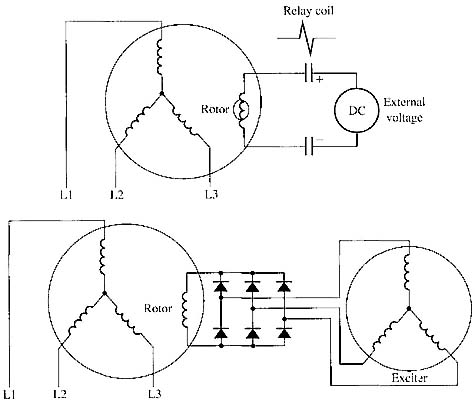AMAZON multi-meters discounts AMAZON oscilloscope discounts
A synchronous motor is an ac motor designed to run at synchronous speed without any slip. The induction motor must have slip of approximately 9 - 10% to operate a maximum torque. Slip is required in an induction motor to allow the rotor to draw enough current to carry its load.
The synchronous motor is designed to operate with no slip by exciting the rotor with dc current once the motor reaches operating rpm. The motor can have dc applied from a dc power source or it can be developed through the use of diodes from a separately generated ac current. This current is produced by a small generator located on the end of the synchronous motor shaft. Prior to the use of modern variable-frequency drives, the synchronous motor was used in industrial applications where the loss of rpm due to slip in an induction motor could not be tolerated and the extra rpm was needed for efficiency. Today the variable-frequency drive can be used to increase the speed of an induction motor to make up the lost rpm so the synchronous motor is not needed as much as it once was.

Above: Fig. 1: Electrical diagram of a synchronous motor.
Fig. 1 shows a diagram of a synchronous motor with the dc voltage developed from an outside source and from an internal source. The diagram, which shows diodes being used to rectify the ac from an internal source, is the most common type of synchronous motor used today. This motor also provides an additional function in that it's capable of correcting power factor. The amount of dc current used to excite the rotor also determines the amount of improvement in the power factor. When it's started, operation of the synchronous motor is similar to that of an induction motor. That is, the motor is started as an induction motor until the motor reaches full rpm. When the motor is at its highest inductive rpm, a switch is closed to provide exciter current to the rotor from the external or internal source.
When the rotor is energized, it will cause its magnetic poles to lock in step with the rotating magnetic field of the motor’s stator. Since the speed of the magnetic field is determined by the number of poles in the motor and the frequency of the applied voltage, the speed of the rotor will be locked into this magnetic field’s speed and they will rotate in unison. The amount of current in the rotor can be adjusted to provide more torque for the rotor. For this reason, it's important that the motor be started without a heavy load applied. The load can he increased as the motor is synchronized.